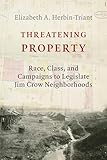Threatening Property : Race, Class, and Campaigns to Legislate Jim Crow Neighborhoods / Elizabeth A. Herbin-Triant.
Material type: TextSeries: Columbia Studies in the History of U.S. CapitalismPublisher: New York, NY : Columbia University Press, [2019]Copyright date: ©2019Description: 1 online resourceContent type:
TextSeries: Columbia Studies in the History of U.S. CapitalismPublisher: New York, NY : Columbia University Press, [2019]Copyright date: ©2019Description: 1 online resourceContent type: - 9780231189705
- 9780231548472
- 305.8009756/0904 23
- E185.61
- E185.61 .H495 2019
- online - DeGruyter
- Issued also in print.
| Item type | Current library | Call number | URL | Status | Notes | Barcode | |
|---|---|---|---|---|---|---|---|
 eBook
eBook
|
Biblioteca "Angelicum" Pont. Univ. S.Tommaso d'Aquino Nuvola online | online - DeGruyter (Browse shelf(Opens below)) | Online access | Not for loan (Accesso limitato) | Accesso per gli utenti autorizzati / Access for authorized users | (dgr)9780231548472 |
Browsing Biblioteca "Angelicum" Pont. Univ. S.Tommaso d'Aquino shelves, Shelving location: Nuvola online Close shelf browser (Hides shelf browser)

|

|

|

|

|

|

|
||
| online - DeGruyter Why Trust Matters : An Economist's Guide to the Ties That Bind Us / | online - DeGruyter Nikolai Nikolaevich and Camouflage : Two Novels / | online - DeGruyter The Death of Idealism : Development and Anti-Politics in the Peace Corps / | online - DeGruyter Threatening Property : Race, Class, and Campaigns to Legislate Jim Crow Neighborhoods / | online - DeGruyter Fandango and Other Stories / | online - DeGruyter Woe from Wit : A Verse Comedy in Four Acts / | online - DeGruyter Malebranche : Theological Figure, Being 2 / |
Frontmatter -- Contents -- Acknowledgments -- Introduction -- 1. Middling Whites in Postbellum North Carolina -- 2. Fusion, Democrats, and the Scarecrow of Race -- 3. Inspirations for Residential Segregation -- 4. Separating Residences in the Camel City -- 5. Jim Crow for the Countryside -- Conclusion: Planning for Residential Segregation After Buchanan -- Notes -- Bibliography -- Index
restricted access online access with authorization star
http://purl.org/coar/access_right/c_16ec
White supremacists determined what African Americans could do and where they could go in the Jim Crow South, but they were less successful in deciding where black people could live because different groups of white supremacists did not agree on the question of residential segregation. In Threatening Property, Elizabeth A. Herbin-Triant investigates early-twentieth-century campaigns for residential segregation laws in North Carolina to show how the version of white supremacy supported by middle-class white people differed from that supported by the elites. Class divides prevented Jim Crow from expanding to the extent that it would require separate neighborhoods for black and white southerners as in apartheid South Africa.Herbin-Triant details the backlash against the economic successes of African Americans among middle-class whites, who claimed that they wished to protect property values and so campaigned for residential segregation laws both in the city and the countryside, where their actions were modeled on South Africa's Natives Land Act. White elites blocked these efforts, primarily because it was against their financial interest to remove the black workers that they employed in their homes, farms, and factories. Herbin-Triant explores what the split over residential segregation laws reveals about competing versions of white supremacy and about the position of middling whites in a region dominated by elite planters and businessmen. An illuminating work of social and political history, Threatening Property puts class front and center in explaining conflict over the expansion of segregation laws into private property.
Issued also in print.
Mode of access: Internet via World Wide Web.
In English.
Description based on online resource; title from PDF title page (publisher's Web site, viewed 02. Mrz 2022)


